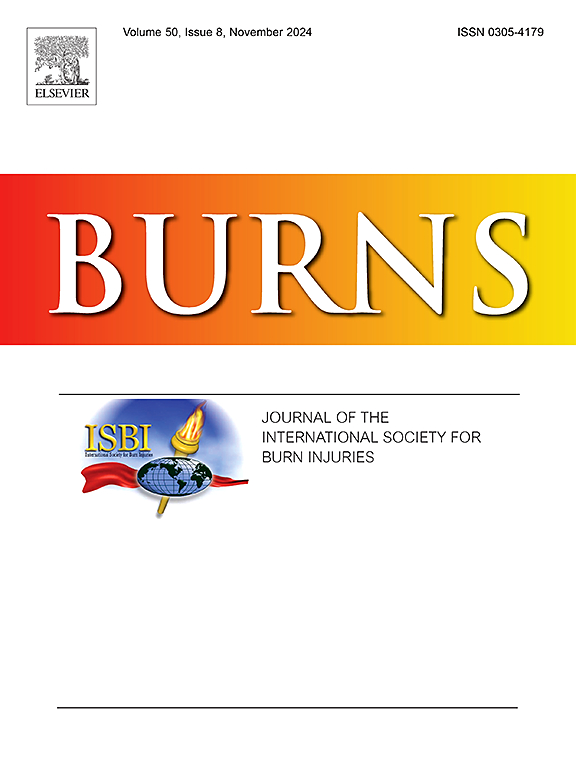重新定义老年烧伤患者的概念:多中心国际数据集分析
IF 3.2
3区 医学
Q2 CRITICAL CARE MEDICINE
引用次数: 0
摘要
背景老年人非常容易受到严重烧伤。通常,“老年人”被接受为≥ 65岁。这种切断是武断的,缺乏有力的证据基础,从临床决策的角度来看可能具有破坏性。研究目的是利用大型国际烧伤数据集,按年龄对死亡风险进行分层,并客观定义预后不良风险明显较高的“老年”患者。方法对RE-ENERGIZE临床试验数据集进行亚分析。RE-ENERGIZE纳入了全球54个烧伤中心收治的1200名2度和/或3度烧伤患者,这些患者预计需要植皮。在一项史无前例的年龄分层研究中,我们以5岁为间隔对主要烧伤患者进行了分层。以3个月死亡率和存活出院时间(TTDA)作为主要和次要结局,进行Logistic回归和Cox比例风险分析。结果3个月死亡率为15.41 %。多变量logistic回归分析显示,年龄与三个月死亡率相关(p = 0.000,OR=1.06, CI= 1.05-1.08),与烧伤总表面积(TBSA%)、急性生理和慢性健康评估II (APACHE II)和Charlson合并症指数(CCI)无关。与所有参考5岁年龄组相比,80岁 + 与死亡率和TTDA的增加独立相关(p ≤ 0.000-0.043)。80 + 组致死剂量50 (LD50)为20.5% %。结论我们提出了严重烧伤患者危险分层的新阈值;≥ 80岁的患者预后明显较差,无论损伤严重程度、由此产生的危重疾病严重程度和包括合并症在内的变量如何,这对预后和管理决策都有影响。本文章由计算机程序翻译,如有差异,请以英文原文为准。
Redefining the concept of the elderly burn patient: Analysis of a multicentre international dataset
Background
The elderly are highly vulnerable to major burn injuries. Typically, ‘elderly’ is accepted as ≥ 65 years of age. This cut-off is arbitrary, lacks a robust evidence base and is potentially damaging from a clinical-decision-making perspective. The study objective was to utilise a large international dataset of major burns to stratify mortality risk by age and objectively define ‘elderly’ patients with significantly higher risk of poor outcome.
Methods
We performed a sub-analysis of the RE-ENERGIZE clinical trial dataset. RE-ENERGIZE included 1200 patients admitted to 54 burn centres worldwide with 2nd and/or 3rd degree burns, who were expected to require skin grafting. In a first-of-its-kind age stratification study, we stratified major burns patients by five-year age intervals. Logistic regression and Cox proportional hazards analyses were performed with three-month mortality and time-to-discharge-alive (TTDA) as the primary and secondary outcomes.
Results
Three-month mortality was 15.41 %. Age was associated with three-month mortality upon multivariable logistic regression analysis (p = 0.000, OR=1.06, CI=1.05–1.08), independently of total burn surface area burned (TBSA%), Acute Physiology and Chronic Health Evaluation II (APACHE II) and Charlson Comorbidity Index (CCI). Age 80 + was independently associated with increased mortality and TTDA, when compared to all referent 5-year age groups (p ≤ 0.000–0.043). The Lethal Dose 50 (LD50) for the 80 + group was 20.5 %.
Conclusions
We present a new threshold of risk stratification in patients with major burns; Patients ≥ 80 years have a significantly poorer outcome, irrespective of injury severity, resultant critical illness severity, and variables including comorbidities, which has implications for prognostication and management decisions.
求助全文
通过发布文献求助,成功后即可免费获取论文全文。
去求助
来源期刊

Burns
医学-皮肤病学
CiteScore
4.50
自引率
18.50%
发文量
304
审稿时长
72 days
期刊介绍:
Burns aims to foster the exchange of information among all engaged in preventing and treating the effects of burns. The journal focuses on clinical, scientific and social aspects of these injuries and covers the prevention of the injury, the epidemiology of such injuries and all aspects of treatment including development of new techniques and technologies and verification of existing ones. Regular features include clinical and scientific papers, state of the art reviews and descriptions of burn-care in practice.
Topics covered by Burns include: the effects of smoke on man and animals, their tissues and cells; the responses to and treatment of patients and animals with chemical injuries to the skin; the biological and clinical effects of cold injuries; surgical techniques which are, or may be relevant to the treatment of burned patients during the acute or reconstructive phase following injury; well controlled laboratory studies of the effectiveness of anti-microbial agents on infection and new materials on scarring and healing; inflammatory responses to injury, effectiveness of related agents and other compounds used to modify the physiological and cellular responses to the injury; experimental studies of burns and the outcome of burn wound healing; regenerative medicine concerning the skin.
 求助内容:
求助内容: 应助结果提醒方式:
应助结果提醒方式:


